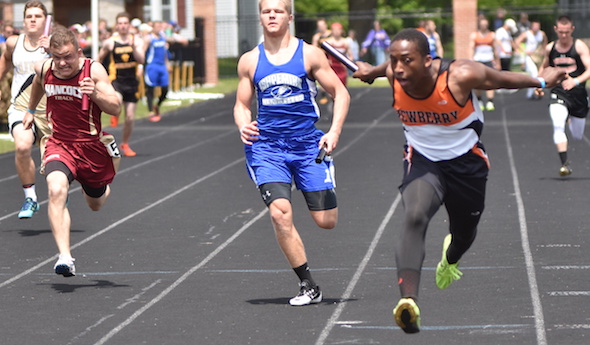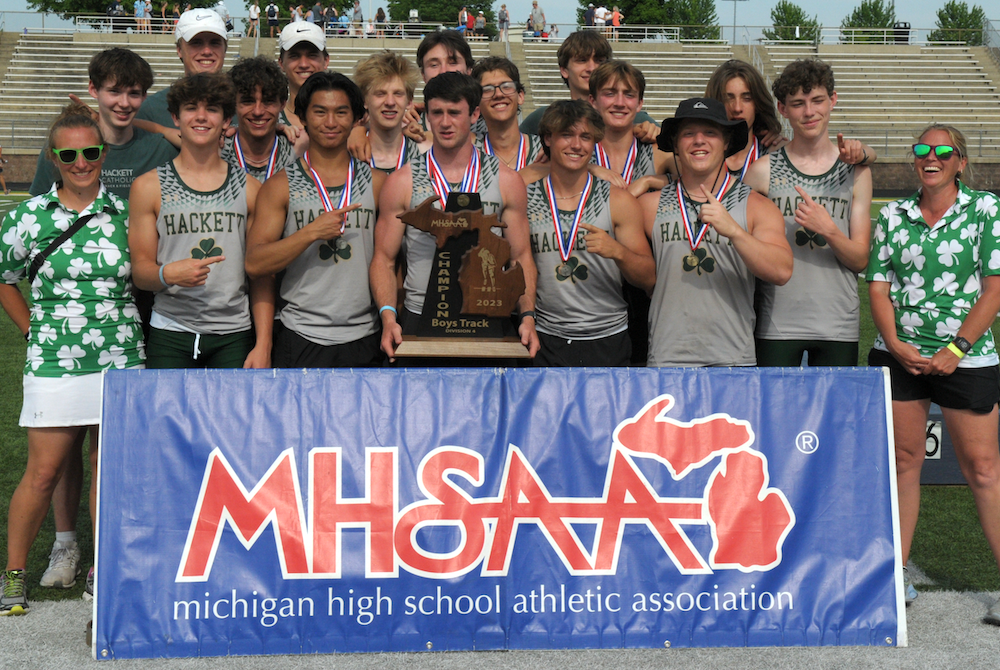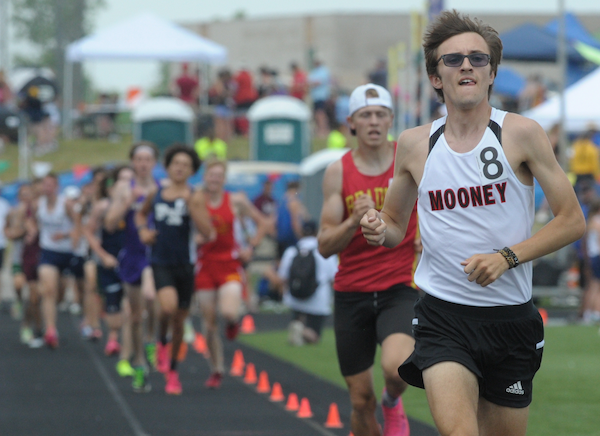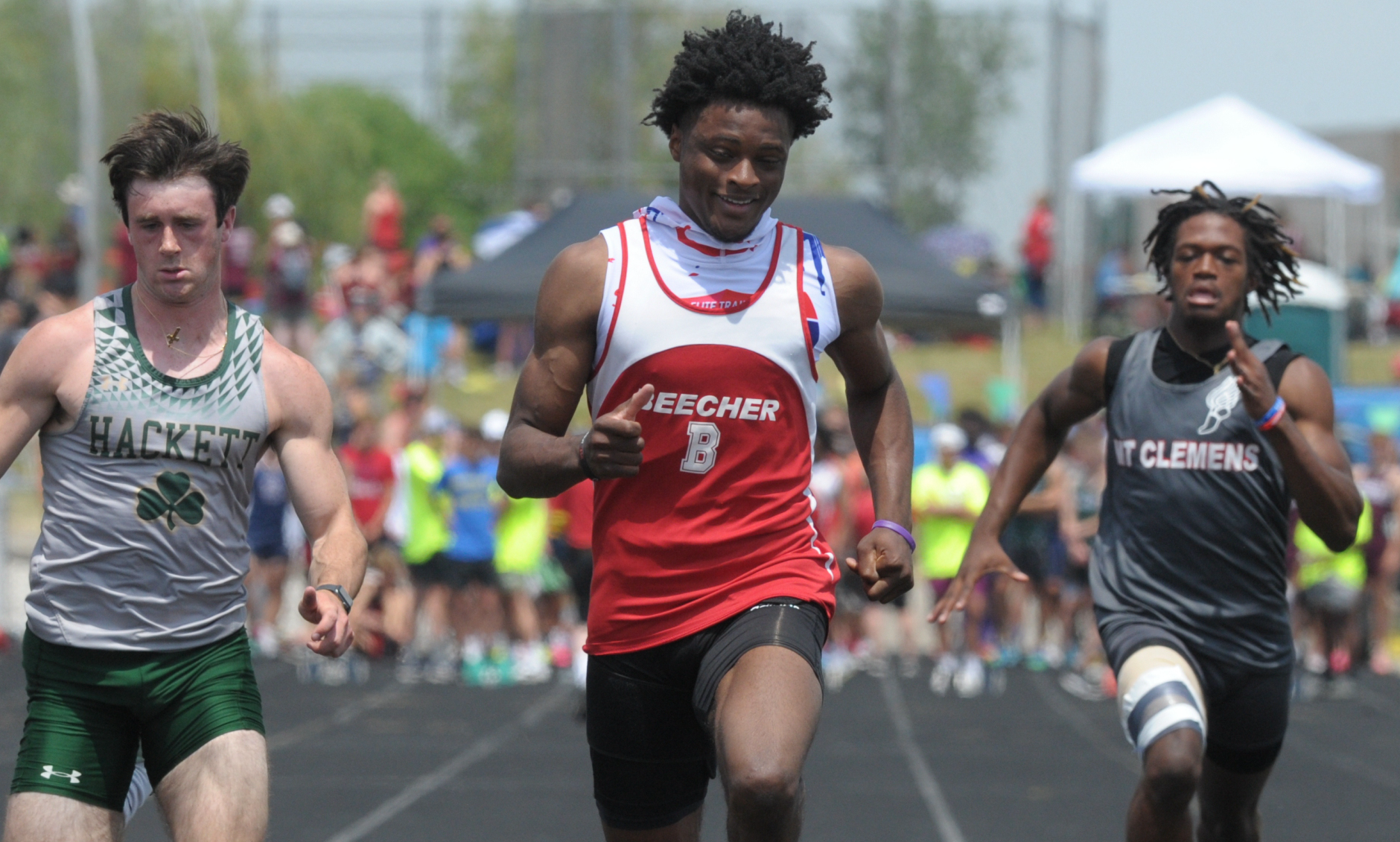
Fast and Steady, Newberry Wins Race
By
John Vrancic
Special for MHSAA.com
June 4, 2017
KINGSFORD — Steady improvement through this season paid off for the Newberry boys track team Saturday as it scored 130½ points to win its first Upper Peninsula Division 2 title in 11 years.
The Indians were followed by three-time defending champ Ishpeming with 102 and Stephenson at 58.
“We had a lot of great performances,” said Newberry coach Gene Schroll. “Our goal was to improve through the year, and we did that. We had our share of firsts and scored in every event. We were fortunate enough to have four good seniors.”
Senior John Paramski had a hand in four firsts, taking long jump at 18 feet, 10 inches, shot put (48-7) and discus (119-5) and helping the Indians take the 400-meter relay in a U.P. Division 2 Final-record 45.03 seconds on a day that saw temperatures soar above 80 degrees in Dickinson County. St. Ignace previously set the 400 relay record (45.11) in 2009.
“The weather and atmosphere helped,” said Paramski, who will play football at Michigan Tech this fall. “When you have all the teams here, it really motivates you. It’s nice to have everything come together in the U.P. Finals.
“I didn’t have my best throw in disc, but it was good enough.”
Classmate Alex Johnson won the 110 hurdles in 15.99 seconds, edging Norway’s Inocenio Stankevich on a lean, and placed third in the 300 (43.69).
 Ishpeming senior Grady Kerst took first in the 800 (2:00.65) and 1,600 (4:29.11), anchored the winning 3,200 relay (8:37.40) and was runner-up in the 3,200 (10:36.22).
Ishpeming senior Grady Kerst took first in the 800 (2:00.65) and 1,600 (4:29.11), anchored the winning 3,200 relay (8:37.40) and was runner-up in the 3,200 (10:36.22).
The Hematites also took the 800 relay (1:35.69) and placed second in the 400 (45.70) and showed their depth in the distances.
Ishpeming’s Daren Guichin was runner-up in the 800 (2:10.73), with Kyle Pruett fourth (2:12.62).
In the 1,600, Spencer Giroux placed third (4:42.15), followed by teammate Jonah Broberg (4:54.45). Giroux also took third in the 3,200 (10:40.13).
Stephenson sophomore Montell Glover became a triple winner, taking the 100 (11.41), 200 (23.65) and 400 (50.76) and anchoring the second-place 800 relay (1:36.51)
Munising sophomore Matt Revord set a meet record in pole vault (13-6), topping the previous best (12-6) by Sam Winkler of Stephenson in 2001.
“In practice, I’ve been working on getting vertical,” said Revord. “I had 13-9 cleared, but came down on the bar. I definitely felt quick on the runway, but I wasn’t as fast as on other days. I’ve been working on inversion for the most part.”
Ironwood sophomore Nick Niemi took the 3,200 (10:20.23), anchored the winning 1,600 relay (3:43.47) and placed second in the 1,600 (4:36.99).
PHOTOS: (Top) Newberry’s anchor runner stretches to finish a meet record run in the 400 relay Saturday. (Middle) Ishpeming’s Grady Kerst passes Newberry’s Kindred Griffis during the 3,200 relay. (Photos by Cara Kamps.)

Thrower Claims Lone Individual Title to Lead Hackett to Team 3-Peat
By
Tom Lang
Special for MHSAA.com
June 3, 2023
Kalamazoo Hackett Catholic Prep just keeps winning and winning.
This time the Irish took home their fourth title in the last five Lower Peninsula Division 4 Track & Field Finals, on Saturday at Hudsonville.
Hackett’s only individual title was taken by discus winner Nathan Buchmann, a senior, who was fine knowing he was the shortest in stature among all the sizable competitors.
“In the offseason after football I worked out every day, working towards this goal,” he said after getting his medal. “I would say this takes 80 percent technique and 20 percent strength to throw the discus. So, length can help but if you have good technique and are really strong, that will play into it.
“I think we are very balanced throughout the meet today,” he said about teammates that scored points in finishes other than first place. “We have 13 guys here today, and we have people in a lot of the races. But I do not run; I have too short of legs to be a fast runner,” he said with a chuckle.
Buchmann had to work through a hip injury to compete this spring.
“I think the setbacks are what make you strong,” he said. “You can either give up through the setbacks or push forward and become better.”
 Coach Charissa Dean agreed.
Coach Charissa Dean agreed.
“The kids have big hearts,” she said after all the points were totaled and the Irish were on top once again, with 53. “They worked hard. They had a lot of potential when we started the season. And we had a lot of drive to put in the work, and we are happy the results came out the way they did.”
Reading was runner-up at 47 points, followed by Wyoming Potter’s House Christian with 42, then Fowler and Flint Beecher each with 37 points.
Senior Lezawe “Moses” Osterink, of Potter’s House Christian, placed second in 1,600 but took the 3,200 title as defending champ of both. He dominated the latter by lapping the field with a final lap kick that resembled more of a superhero speedster.
“Nobody really took it out that hard at the start,” he said. “There was a freshman (Marek Butkiewicz of Hackett) that tried to get the pace going quick, but me and Dakota (Dykhuis of Montabella) just kind of sat back and gradually pulled him through.
“We took it gradually, and I was just relying that I could kick.”
Kick did he ever. The trio were neck and neck the majority of the race in a grouping ahead of the pack.
“With 400 to go I just tried to go all out,” Osterink said. “I had a lot more left than I thought and I was pleased with the win. Not really the time, but that doesn’t matter, especially this hot out.”
The overall meet was in the low 90s/high 80s heat and searing sun all day. So, race officials allowed the unique opportunity for coaches to spray the runners with water and give them water bottles.
“It was very weird because I’ve never taken water to drink while I’m running, so I didn’t know how that would feel,” Osterink said. “And they were spraying us and hitting us in the face. It was kind of fun.”
Junior Tyler Lenn of Marine City Cardinal Mooney defeated Osterink at his own game in the 1,600.
“I’m feeling great,” Lenn said after grabbing the medal. “I said to a newspaper after one of my races (during the season) I was right where I wanted to be. This has been a long rebuilding process for me since an injury back in the fall, and I set a pretty high goal the day the injury happened. I was telling myself I needed to fulfill what I said I would do at the beginning of last cross country season. And that is what I did today.”
Lenn suffered an ankle sprain from a misstep that turned worse because he kept running through the season on it.
“Coming back from that was pretty tough, but I wouldn’t have it any other way,” he said.  “Perseverance; I said from the beginning what I was going to do. I kept my eye on that target, and no matter the circumstances life threw at me, that I was going to make it happen and I am a man of my word.”
“Perseverance; I said from the beginning what I was going to do. I kept my eye on that target, and no matter the circumstances life threw at me, that I was going to make it happen and I am a man of my word.”
Jaylin Townsend, a senior from Flint Beecher, dominated the short races. He won the 100 dash (10.67) and 200 dash at 22 seconds flat. It was his third 100 win at a Finals.
“I put in a lot of work; I had to three-peat,” he said after the 100. “There’s a lot of great competition here, so I knew I had to come out and run my best.”
Concord in the 400 (43.72), Buckley in the 800 (1:30.76) and 1,600 (3:29.13) and Potter’s House in the 3,200 (8:14.18) were relay champs Saturday. Reading’s Tayshawn Bester won the 110 hurdles (15.13), and Athens’ Landen Bennett won the 300 (39.85). Caseville’s Nathan Feltner won the 400 (50.76), and Vestaburg’s Owen Patton claimed the 800 (1:55.11).
Fruitport Calvary Christian’s Bradley Richards won the high jump (6-10), and Peck’s Alex Affer won the long jump (23-4). McBain Northern Michigan Christian’s Isaac Bowden was first in pole vault (13-0), and Brown City’s Kyle Affer won shot put (49-2).
PHOTOS (Top) Kalamazoo Hackett Catholic Prep celebrates its third-straight LPD4 title Saturday. (Middle) Cardinal Mooney's Tyler Lenn, far right, sets the pace in the 1,600. (Below) Flint Beecher's Jaylin Townsend, middle, crosses the finish first for one of his two sprint championships. (Photos by Ken Swart/RunMichigan.com.)

